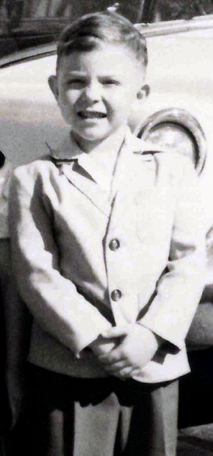 |
 |
A Texan, by way of California, born in Arkansas, I am, as my personal website asserts, “an over-educated American of Northern European origin.”
During my time in graduate school at the University of Texas at Austin, I worked with Dr. Ralph R. Read III on several projects, translating German literature into English. Foremost among these was Horst Bienek’s Die Erste Polka [The First Polka], a novel situated in Nazi-Era Upper Silesia. In Herr Bienek’s honor, one of the characters in David, My David (Josef Piontek) shares the name [but, except for the hometown, not the history] of a character from that volume. This family-name was also Herr Bienek’s mother’s maiden name.
Other texts that I helped Dr Read with translation were by modern German writers, such as Peter Weiss. (Modern German literature was Dr. Read’s field of specialty.)
I had spent part of my undergraduate college years studying the relationship between Beethoven and Goethe, to the point of having to learn to read their handwriting (although, in Beethoven’s case, it was more of a Kurrent-based scrawl), and so was exposed to much of the intricate niceties of German society of the late 18th and 19th centuries.
Beyond Johann Wolfgang von Goethe and those aforementioned, more modern writers, I have been most influenced in literature by Heinrich Heine and Thomas Mann. Homage to these three is paid throughout David, My David, indirectly, if not overtly.
In the music that suffuses this saga, one sees a devotion to Robert Schumann, Gustav Mahler, Beethoven, Bach, Brahms and Rachmaninoff, among others. There is also the extensive influence of Edi’s “my Clara” (Robert Schumann’s wife, and friend of Brahms), as teacher and now unfairly-neglected composer.
In October of 2018, I traveled to Germany for the first time, alone. It was gratifying to learn that everything I had researched from afar was true to its portrayal within David, My David. The streets of Frankfurt am Main were confusing at first, though, because I had learned the layout of the city as it had existed during the youthful, pre-war years of the novel’s main character, that is, from the late 1920’s through 1938.
I was also puzzled by the fact that it seemed that I was purposely singled out by foreign tourists, when they needed information or directions. Pondering this later, after having returned to my hotel room, I glanced up into a mirror. That’s when I realized that I had the lightest-color hair of anyone that I remembered having seen there in Frankfurt.
Blond, 6-foot, wide-shouldered, I was, apparently, the most stereotypically “German-looking” person those tourists could find. It seemed to be unconscious racism on the part of those, mostly eastern-European tourists. A greater shock was delivered some five months after I had returned to the U.S.
It was then that I was informed by 23andMe that they had re-evaluated the 20% of my DNA that they had originally tagged “general Western European.” When I clicked into their website, the first location that appeared from this new evaluation was “Germany.” A second click, to its narrower definition, and the location that appeared was “Hesse.”
Suddenly, I had learned that, during all those years of research, writing and translating, I could have been writing about my own, Hessian family! My maternal-maternal great-grandmother was of Hessian descent. Because of the way in which they are inherited only from the mother and her female forebears, I have German mitochondria.
Subsequent research into the paper-record trail then showed not only that 23andMe had been completely correct, again, but that I also had at least one additional line of German descent on my father’s side. Indeed, I am a 16th generation descendant of Jakob Fugger von der Lilie der Ältere, of the famous Fugger banking and industrial family, from Augsburg, Bavaria.
This new knowledge has made me wonder if all that could be why some people in Berlin, with whom I spoke German, thought I was from (now Hessian) Frankfurt, and if it could be one reason why the saga I tell of Eduard Meyer is so intensely personal, to the point that one friend jokingly accused me of having written an “autobiography by proxy” and that, with this book, I had written a love song to that democratic Germany that, with the efforts, concepts and ideals of the Revolution of 1848-9, could have been, should have been, and is now trying to be realized.
I speak and write in General North-American English, to my own, high standard, as documented within my reference book, The Qualls Concise English Grammar.
The German phrases embedded within David, My David are all written in the good, long-used, Weimar-period, pre-Nazi orthography, not in the pseudo-etymological Ssscheißorthographie imposed, in grievous error, in the late 1990’s.
Several of the book’s German phrases are also formatted in Fraktur, the traditional “black letter” font, used for most German texts printed in Germany or Austria until Hitler banned it, declaring it (in blatant stupidity) to be a dissolute, anti-German, “Jewish” invention. [Created by me from traditional print, each of the variants of the Fraktur font used within the book is available gratis, here.]
One compelling reason I have for continuing to bring this book, and its precepts, to the fore is that I learned only recently, through newly published, old newspaper clippings, that my first lover, Donald Schluterman, was murdered in his Houston apartment in May of 1987, in a hate crime that occurred some 10 years after I had last seen him.
This senseless act, the brutal attack on this gentle soul, should remind all of what is at stake, of what the world has to lose, to encourage us to redouble our forceful cry that “Hatred is laziest form of cowardice.”